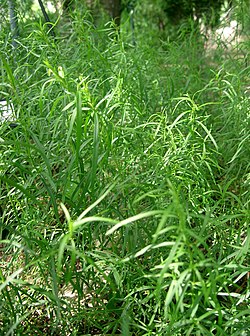Tarragon
| Habit | herbaceous
| |
|---|---|---|
| Lifespan: | ⌛ | perennial |
| Exposure: | ☼ | sun |
|---|---|---|
| Water: | ◍ | moderate, dry |
| Features: | ✓ | fragrance, edible |
Tarragon or dragon's-wort (Artemisia dracunculus L.) is a perennial herb in the family Asteraceae related to wormwood. Corresponding to its species name, a common term for the plant is "dragon herb." It is native to a wide area of the Northern Hemisphere from easternmost Europe across central and eastern Asia to India, western North America, and south to northern Mexico. The North American populations may, however, be naturalised from early human introduction.
Tarragon grows to 120-150 cm tall, with slender branched stems. The leaves are lanceolate, 2-8 cm long and 2-10 mm broad, glossy green, with an entire margin. The flowers are produced in small capitulae 2-4 mm diameter, each capitulum containing up to 40 yellow or greenish-yellow florets. (French tarragon, however, seldom produces flowers.[1])
Read about Tarragon in the Standard Cyclopedia of Horticulture
|
|---|
|
Artemisia dracunculus, Linn. Tarragon. Estragon. Herb; green and glabrous, with erect, branched sts. 2 ft. high: radical Lvs. 3-parted at the top; st.-lvs. linear or lanceolate, entire or small-toothed: panicle spreading, with whitish green, nearly globular fl.-heads. Eu. R.H. 1896, p. 285.—Tarragon Lvs. are used for seasoning, but the plant is little grown in this country. The Lvs. may be dried in the fall, or roots may be forced in a coolhouse in the winter. Prop, by division; rarely produces seed. See Tarragon.
|
Read about Tarragon in the Standard Cyclopedia of Horticulture
|
|---|
|
Tarragon (Artemisia Dracunculus, which see) is a close relative of wormwood (A. Absinthium). It is a perennial composite herb native of the Caspian Sea region and Siberia, and is cultivated as a culinary herb in western Europe. Its lanceolate entire leaves and small inconspicuous and generally sterile blossoms are borne upon numerous branching stems, 2 to 3 feet tall. Its green parts, which possess a delicate aromatic flavor resembling anise, are widely used for seasoning salads and for flavoring vinegar, pickles, and mustard. The essential oil of tarragon and tarragon vinegar are articles of commerce, the crop being grown extensively in southern France for this purpose. The former is obtained by distillation of the green parts, the latter by simple infusion in vinegar. The best time to gather the crop for distillation or infusion is when the first flowers begin to open, since the plants have then a larger percentage of oil than before or after. From 300 to 500 pounds of green parts, according to seasonal and other conditions, are needed to produce one pound of oil. As cultivated tarragon rarely produces viable seed, the plant is propagated by cuttings of both old and green wood and by division of the roots. Cuttings may be taken at any convenient time, but the best time for the division is when the plants have just begun to grow in the spring. Tenacious and wet soils should be avoided and only loams of medium texture and of poor quality in sunny situations chosen. The plants may be set, either in the spring or in the autumn, 1 foot apart and cultivated like sage or mint. The flower-stems should be removed as soon as seen, as this will force greater growth of leaves. The green parts may be gathered at any time, after the plants have become established, and used fresh. Dried tarragon is nearly as useful as green, but there is little market for it, less even than for the leaves. At the approach of winter, especially in cold and snowless climates, the stems should be cut down and the plants covered with litter or leaves. The position of the beds should be changed every three or four years. Tarragon is less cultivated in America than it deserves. Most of our tarragon vinegar comes from France. A wholly different plant, Tagetes lucida, is much like tarragon in flavor and has been used as a substitute for it.
|
Describe the plant here...
Cultivation
French tarragon is the variety generally considered best for the kitchen, but cannot be grown from seed[citation needed]. It is normally purchased as a plant, and some care must be taken to ensure that true French tarragon is purchased[citation needed]. A perennial, it normally goes dormant in winter.[1] It likes a hot, sunny spot, without excessive watering.[1]
Russian tarragon (A. dracunculoides L.) can be grown from seed but is much weaker in flavour when compared to the French variety.[1] However, Russian tarragon is a far more hardy and vigorous plant, spreading at the roots and growing over a meter tall. This tarragon actually prefers poor soils and happily tolerates drought and neglect. It is not as strongly aromatic and flavoursome as its French cousin, but it produces many more leaves from early spring onwards that are mild and good in salads and cooked food. The young stems in early spring can be cooked as an asparagus substitute. Grow indoors from seed and plant out in the summer. Spreading plant can be divided easily.
Propagation
Pests and diseases
Varieties
Gallery
References
- Standard Cyclopedia of Horticulture, by L. H. Bailey, MacMillan Co., 1963
External links
- w:Tarragon. Some of the material on this page may be from Wikipedia, under the Creative Commons license.
- Tarragon QR Code (Size 50, 100, 200, 500)





